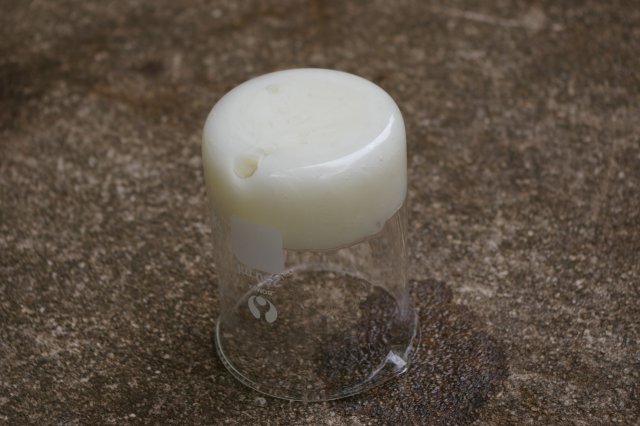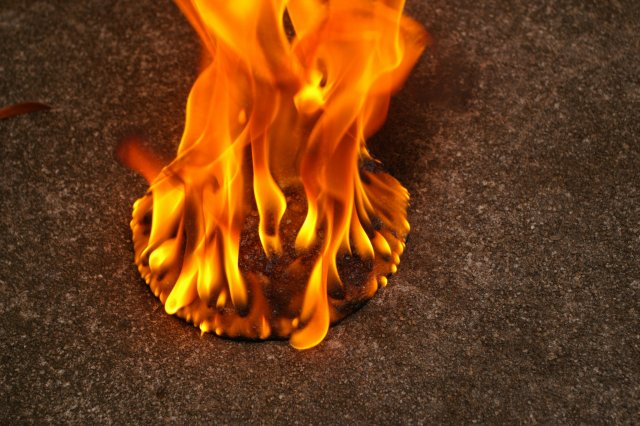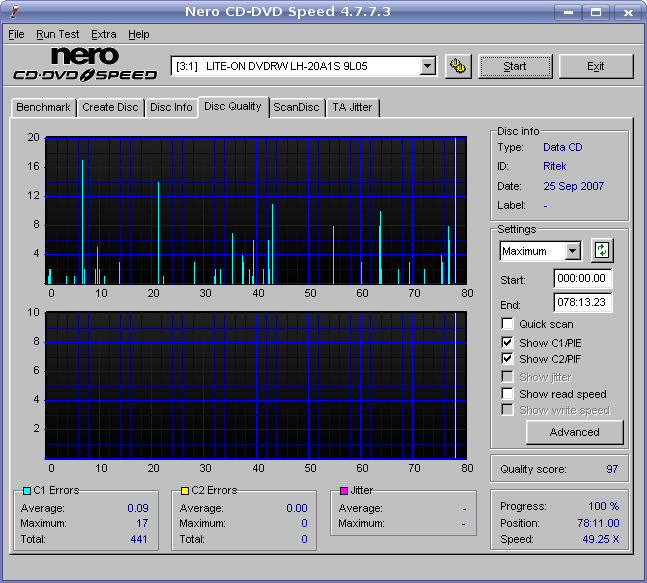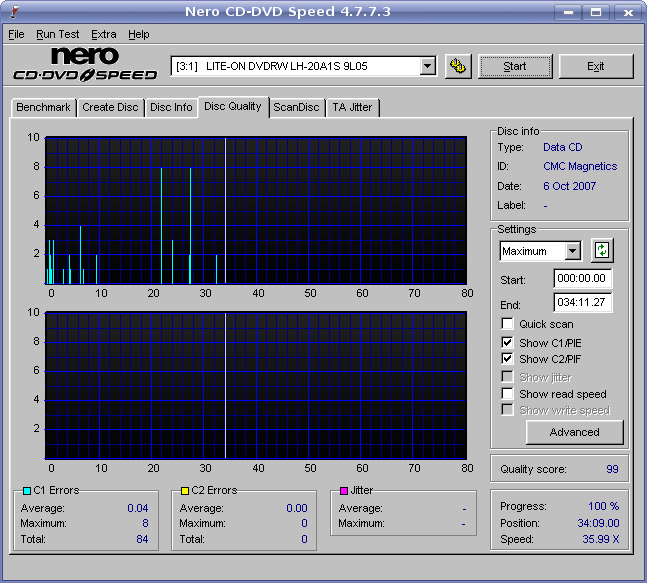
|
Daynotes
Journal
Week of 1 October 2007
Latest
Update: Saturday, 6 October 2007 11:05 -0400 |

|
08:31
-
The home chem lab book is really coming together now. I have a lot left
to do, but I should have a completed manuscript by the end of this
month. If you're a subscriber, you can look at some reasonably complete
first-draft chapters on the subscriber page.
You can also look at most of the chapters of the new astronomy book. If
you want to see those, grab them immediately. I'll be removing
them in the next day or two. My editor tells me that the astronomy book
should go to the printer at the end of this month, so it should be in
the bookstores not long thereafter.
Yesterday,
I spent some time cleaning up, archiving old mail, sweeping stuff from
working directories into archive directories, burning backup DVDs, and
so on. I also worked on a summary spreadsheet for required equipment,
supplies, and chemicals, lab-by-lab. I started with chapter 6, which is
the first lab chapter. I listed each item on the list of items required
for lab 6.1 in the left column of the spreadsheet, including the
maximum number required, and then under a "lab" column, entered "6.1"
for each of those items. Then I did the same for lab session 6.2, 6.3,
6.4, and so on.
When I finish writing all the lab sessions and
add the items needed to this spreadsheet, I'll have a
consolidated list of required equipment, supplies, and
chemicals--with quantities--which I'll use to modify the chapters on
equipment and chemicals. I'll also use it to modify some of the lab
sessions themselves. For example, it's often not critical exactly which
item is used in a lab session. A 150 mL beaker might serve as well as a
250 mL beaker, or a 125 mL Erlenmeyer flask, for that matter. As I've
written the labs, I've used whatever seemed reasonable at the time, but
inevitably I've ended up using different items in different lab
sessions even though the same item might have served for both lab
sessions. So, in the interest of minimizing required items, I'll go
back through the list, trim it down as much as possible, and rewrite
the required items list for particular lab sessions where necessary.
08:28
-
I'm still cranking away on the home chem lab book, right now on the gas
chemistry chapter. When Paul Jones stopped by the house yesterday to
drop off some stuff, I mentioned that I was using a bath of dry ice in
alcohol to reach low temperatures. Paul suggested a neat prank. Put a
chunk of dry ice in a disposable latex glove, knot the top, and
leave it somewhere inconspicuous. As the dry ice sublimates, it
inflates the glove, eventually causing a loud pop. The dogs will never
forgive me.
Paul also mentioned an unfortunate student who
pulled the same trick, but using a glass vial instead of a latex glove.
The student put the vial in a metal trash container and made sure that
it was covered with enough trash to prevent flying glass from hurting
anyone, but he still got in trouble for the prank. I was surprised that
the glass fragmented, and Paul was surprised that I was surprised. I
figured that the increased gas pressure would cause the vial's stopper
or lid to give way before the glass fragmented. But in case anyone
doesn't know it already, using a glass container is a really, really
bad idea.
Barbara and I started watching a borrowed copy of Kenneth Clark's Civilisation
Sunday night. Neither of us had seen it when it first ran on PBS back
in 1969, but based on the uniformly excellent reviews we decided to
give it a try. We made it through three of the four episodes on Disc 1
Sunday night, and watched the fourth episode last night. We finally
decided that enough was enough. Not only is this not a great series, it
isn't even a good one.
The story of civilization is the story of
science, technology, engineering, and industry. Clark utterly fails to
understand that. This series is actually a history of art with a strong
emphasis on religion, and not a very good history at that. Art is one
by-product of civilization, not its cause. And religion is not an
enabler of civilization, but an impediment to its development.
In
essence, civilization develops when sufficient wealth accrues in excess
of subsistence needs to allow smart folks to devote time to pursuits
other than getting enough to eat. And the enablers of that are science,
technology, engineering, and industry.
09:46
-
One other thing Paul mentioned yesterday puzzled me. I told him I'd
been using dry ice in an ethanol bath and reached -59 °C. Paul
commented that I could get it colder if I used isopropanol. I got to
thinking about that, and sent him the following message:
From: Robert Bruce Thompson
To: Paul Jones
Date: Mon Oct 1 15:26:20 2007
Re: Ethanol versus isopropanol
Okay,
what you said has been driving me nuts all day. Why would dry ice in
isopropanol reach a lower temperature than dry ice in ethanol? Dry ice
sublimes at atmospheric pressure at -78.5 °C, right? That's higher than
the freezing point of either ethanol or isopropanol, so why would it
matter which one I used?
It
seems to me that the dry ice would absorb heat from either alcohol
until the mixture reached equilibrium at -78.5 °C. (Of course, my
experimental results showed a minimum temperature of -59 °C, which may
well be error in my electronic thermometer.)
From: Paul Jones
To: Robert Bruce Thompson
Date: Tue Oct 2 09:04:36 2007
Re: Re: Ethanol versus isopropanol
Good
question that. I was thrown off by your saying it was -59 C and
didn't question that number. I knew you'd get -78 with iPrOH, so
suggested it. Of course, you're right, you'll get -78 (or close
to it - the table posted in my lab says -72, though I don't know why)
using EtOH. Pretty much no difference. I'd guess either you
didn't truly reach equilibrium or your thermometer isn't accurate at
that cold of a temperature.
As
for the vial, I think you might have misunderstood. It was a
screw top cap, so it couldn't readily pop off. Certainly any sort
of stoppered vial would pop the stopper before fracturing the glass.
Not a bad way of firing projectiles, if you don't mind
uncertainty in when it will fire.
Liquid
N2 in a 3 L plastic soda bottle is also fun. And sort of
intermediate in danger between a glove and a glass vial. Not sure
if your readers will have access to liquid N2. We have a high
school/junior high program in the summer in which a teacher does that
demo outside (make sure this one is outdoors - indoor and you'll
rupture some eardrums). It usually sets off car alarms and I
think campus security took umbrage last time she did it.
From: Robert Bruce Thompson
To: Paul Jones
Date: Tue Oct 2 09:45:12 2007
Re: Re: Ethanol versus isopropanol
I'm
sure you're right. IIRC, my electronic thermometer is rated as being
accurate to 0.1 °C or 0.2 °C from 0 °C to 100 °C and to 1 °C from -40
°C to 0 °C and from 100 °C to 150 °C. Given that the bath was probably
nearly 40 °C colder than the rated minimum for the thermometer, it
wouldn't surprise me if the thermometer reading was far off the mark.
When
I stuck the probe in the dry ice bath, I suspect it reported something
like, "Geez, I don't sense any voltage to speak of, so it must be
really, really cold in here".
Wednesday, 3 October 2007
08:38
-
I'm still cranking away on the home chem lab book. I should finish up
the chapter on Gas Chemistry today and get started on the Colloids
chapter.
Dr. Paul Jones and Dr. Mary Chervenak have both agreed
to be technical reviewers for the book, which will no doubt make it a
better book than it otherwise would be. Both have an abiding interest
in science education. Paul, obviously, as a professor of chemistry, has
devoted his life to science education. Mary is a working chemist, but
she devotes significant time and effort to speaking at schools and
helping to introduce children to science. Other than the astronomy
books, this book is my first effort to popularize and evangelize
science to young people, and I appreciate their support.
Nothing
is ever certain when it comes to future books, but I hope to do a
series of home lab books for O'Reilly, including physics, biology,
earth science, and perhaps even forensics. Only time will tell.
07:57
-
The Gas Chemistry chapter is finished and posted. I should have the
chapter on Colloids and Suspensions finished tomorrow, after which I go
back and rewrite a couple of the early narrative chapters. This book is
really starting to come together.
Last night, I downloaded and
burned the Ubuntu 7.10 beta ISO and installed it on my den system.
Obviously, they're still doing a lot of work on it. As soon as the
install finished, a notification popped up that there were updates
available. So I downloaded and installed 321 MB of updates, played
with the system for a while, and went to bed. This morning, a
notification popped up to tell me that there were 19 more updated files
available. Despite all the updates (or perhaps because of them), the
system seems completely stable. Everything I tried just worked. The
final version is to be released later this month, and it looks like
it'll be a good one.
Barbara and I closed on our house 20 years
ago tomorrow, and moved in later that day. We hadn't moved our
furniture that day, so we ended up sleeping on the floor in the den. In
celebration of the 20th anniversary, we plan to sleep on the floor in
the den tomorrow night.
Actually, it's more than the 20th
anniversary of the closing. Our mortgage is also paid off this month.
Jerry Pournelle frequently mentions Robert A. Heinlein's advice to
writers. As professional gamblers, he said, we should make sure that
our house and car are paid for. As of this month, that's true for us.
10:25
- The judge in Capitol v. Thomas made a bad call this morning.
As of yesterday afternoon, the proposed jury instructions provided by
the judge included #14, which would have told the jury that "making
available" was insufficient to establish copyright infringement. The
plaintiff (RIAA) objected to that instruction, and after discussion
with the attorneys of the plaintiff and defendant, the judge modified
that instruction to say that "making available" was sufficient to
establish copyright infringement.
Basically, it comes down to
the question of whether simply storing music files in a
publicly-accessible directory with a P2P product like Kazaa is
sufficient to establish copyright infringement, or whether the
plaintiff has to prove that someone actually downloaded those files. By
any reasonable definition, "making available" is insufficient to prove
copyright infringement. Copyright infringement requires, obviously,
that a copy be made. Simply establishing that a defendant was "making
available" those files does not establish that any unauthorized copying
occurred.
Now, some might argue, as did a witness for the
plaintiff, that it was "obvious" that unauthorized copying occurred.
Perhaps it was obvious to her, but it is not obvious to me, and it
seems to me that the burden should be on the RIAA to prove that actual
copying took place. If you think my position unreasonable, consider
this: when a library lends an audio CD to a patron, does that
constitute copyright infringement? If not, why not? There is no logical
difference between the library "making available" that CD to the patron
and what the RIAA has allegedly(*) established Ms. Thomas did. How
about if you lend an audio CD to a friend? According to the RIAA's
position, you are "making available" that CD and therefore infringing
copyright.
* I say "allegedly" because the RIAA has actually established no such
thing; all they have established is that the files in question were
available on a shared volume at a particular IP address, and an IP
address in no way maps definitively to a particular person, nor with NAT commonplace even necessarily to a particular computer.
08:25
-
The judge in Capitol v. Thomas blew it big time. Not only did he
wrongly modify his original jury instruction #14 to say that finding
Ms. Thomas guilty of distribution didn't require that she be found to
have distributed, but he handcuffed the jury by limiting it to
assigning damages of $750 to $150,000 per track. It seems to me that a
range of $0.70 to $150,000 would have been more reasonable, given that
the RIAA actually values a track at $0.70 if iTunes is any evidence.
Meanwhile, during an interview in USA Today, Bill Gates casually admits to doing more than Ms. Thomas was accused of. FTA:
Q: What's the coolest thing about the upgraded Zune?
A:
Look at this thing! (Holds up a Zune 8) Three or four years ago there
was nothing like this. This is cool as heck. I'm finding music I
haven't seen in 20 years. Hey, the Lovin' Spoonful? They're in this
thing. I find one of their songs. I send it to friends I had an
apartment with, it was actually 30 years ago. I can send it out to them
and say, "Remember when we listened to this?" It's amazing.
Obviously, Microsoft's DRM applies only to customers, not to Mr.
Gates himself. I wonder why the RIAA hasn't gone after Mr. Gates. They
could offer him one of their bargain deals. "Give us a measly $10
billion and we won't sue you."
No word yet on whether Capitol v.
Thomas will be appealed. I hope it is. But for now there's no doubt
that the RIAA hopes to use the Capitol v. Thomas decision as a club
against victims who balk at coughing up the several thousand dollars
that the RIAA attempts to extort from people they accuse of file
sharing. That may work in the short run, but in the long run the RIAA
is toast. As SCO has proven, suing your customers is not a viable
business model.
Actually, I don't have a lot of sympathy for
people who use P2P software to share copyrighted files. They're either
stupid or inexcusably ignorant. Why risk something as public as P2P
file sharing, when it's simple enough to establish your own darknet or
join an existing one?
I actually had this conversation with
Jasmine a year or two ago. Jas doesn't trade music, and never has. She
buys what she wants on CD, and her music preferences are far from
typical for a girl of 14. But I explained to her why it was dangerous
to use P2P, and suggested that she also tell all her friends to
avoid P2P. It's just as easy and much safer to rip CDs, compress them
to MP3s, and trade them on optical discs or memory sticks. Despite
Jasmine's atypical listening preferences, groups of friends tend to
listen to the same kinds of music, and since 1,000 or more tracks will
fit on a DVD or a large memory stick, it doesn't take long for everyone
to have a copy of what anyone else in the darknet has.
As a
matter of fact, since the RIAA intends to continue sending these
extortion letters to P2P users, it would be a public service for those
of us who understand computers to teach kids how to trade music safely.
Explain to them, not just in general terms but specifically, how to rip
CDs and compress them to MP3 files, how to burn them to optical discs,
how to set up a secure darknet, and so on. We could periodically do
neighborhood workshops.
11:05
-
I finished the chapter on colloids and suspensions yesterday and posted
it to the subscriber page. One of the lab sessions was about producing
a gelled organosol with a gasoline continuous phase and a polystyrene
dispersed phase, AKA Super napalm.
Here are a couple of the
thumbnail images that I embedded in the chapter. The first one is an
inverted 250 mL beaker, showing that napalm is semi-rigid and capable
of resisting the force of gravity. Having made about 100 mL of Super
napalm, I was faced with disposing of it safely. The second image shows
it burning on the concrete pad outside the basement door. As you can
see, the stuff not only sticks, but it doesn't spread much, if at all.
Although
I'm not entirely delighted with the Lite-ON LH-201A1S drive for burning
DVDs, it burns CDs absolutely superbly. The first image is a scan of a
nearly full CD written to a Maxell-branded CD-R disc produced by Ritek.
With zero C2 errors and only 441 C1 errors, this disc is about as good
as anyone could hope to produce.
The
second scan is better still. It's a CD I burned this morning of the
images Barbara shot on her recent trip to Cape Cod. Although this
Verbatim CD-R disc is only about half-full, still there are only 84(!)
C1 errors. This is about as close to perfect a scan as I've ever seen.
Now if I could just get scans this good when I burn DVDs.
00:00
-
Copyright
© 1998,
1999, 2000, 2001, 2002, 2003, 2004, 2005, 2006, 2007 by Robert Bruce
Thompson. All
Rights Reserved.







